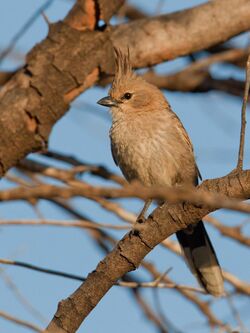Biology:Chirruping wedgebill
| Chirruping wedgebill | |
|---|---|

| |
| Scientific classification | |
| Domain: | Eukaryota |
| Kingdom: | Animalia |
| Phylum: | Chordata |
| Class: | Aves |
| Order: | Passeriformes |
| Family: | Psophodidae |
| Genus: | Psophodes |
| Species: | P. cristatus
|
| Binomial name | |
| Psophodes cristatus (Gould, 1838)
| |
The chirruping wedgebill (Psophodes cristatus) is a medium-sized member of the genus Psophodes, which consists or four to five songbirds endemic to Australia.[2] Commonly found in low shrublands in south-eastern inland Australia,[3] the species is distinguished by its distinctive, chirruping call.[3] The chirruping wedgebill and chiming wedgebill (Psophodes occidentalis) were considered to be a single species until as late as 1973, when they were separated due to marked differences in their calls.[3]
Taxonomy
John Gould originally described P. cristatus and P. occidentalis as one species (Sphenostoma cristatum),[4] and this remained common practice until c. 1973.[5] The separation of the species at that date was based mainly on differences in song and range.[3]
Description
The chirruping wedgebill is a medium-sized bird, measuring approximately 18–21 cm and weighing 31-64 g.[3] Its bill is dark and wedge-shaped when mature, and horn-coloured when immature. It possesses a slim upright crest, and long rounded tail.[3][6] Adult plumage consists of pale brown upperparts, with white/pale grey underparts. Flight feathers are edged with white, and the tail is coloured dark black-brown with a white tip. Immature individuals possess similar plumage, the only key differences being buff-tipped flight feathers, unlike the white tips of the mature individual.[3][6]
This bird is often misidentified as the chiming wedgebill (Psophodes occidentalis). Key identifying features include the faint breast streaking, slightly longer tail, and repetitive chirruping call.[3][6]
Call
The distinctive call of this species is described as an antiphonal duet. Accounts of the call differ slightly. Pizzey and Knight describe the male as calling sitzi-cheeri (similar to the budgerigar's rolling chirrup), while the female replies with an upward rolling r-e-e-e-t CHEER.[6] The call is described by Simpson and Day, however, as "sparrow-like and repetitive". Male chirrrp, female response of ee cheer.[7]
Distribution and habitat
The chirruping wedgebill is found throughout south-eastern inland Australia, inhabiting low, open shrublands with acacia species.[3][6] Distribution is patchy, but where found, the species is usually locally abundant. Though the species covers a large area, it is rarely found in the southern part of its range. It tends to favour areas with vegetation of bluebush, acacia stands, emu bush and lignum species.[3]
Ecology
The chirruping wedgebill is territorial throughout the year. Adults are generally sedentary, with small flocks of up to 20 birds being regularly recorded.[3][8] Juvenile birds tend to be more widely dispersed, sometimes forming loose foraging flocks of up to 100 individuals, that wander over greater distances than the adults.[8] The species is unobtrusive and reserved (though less shy than the chiming wedgebill), except when calling. While foraging, individuals make short flights (small flutters and glides) or run between cover.[3] The species is non-migratory.[9]
Diet
The chirruping wedgebill feeds predominantly by foraging for seeds and insects.[3][5][8]
Breeding
The species has several breeding seasons throughout the year: from March to May, and August to November, as well as after rain. The nest consists of a loose, shallow cup of grass, twigs and bark (lined with smaller, fine material). It is generally built in the fork of a dense tree, shrub or mistletoe, generally no more than 3 metres above the ground.[3][8] Two to three blue-green eggs with sparse dark blotches are laid at a time. The eggs are of a tapered-oval shape, measuring approximately 24 x 17 mm. Incubation length is unknown. The life span of this species is approximately 6.4 years.[9] It is not known if the sexes possess different roles in food collection or parenting.
Conservation
The chirruping wedgebill is classified as Least Concern by the IUCN.[1]
References
- ↑ 1.0 1.1 BirdLife International (2017). "Psophodes cristatus". IUCN Red List of Threatened Species 2017: e.T22705339A118693539. doi:10.2305/IUCN.UK.2017-3.RLTS.T22705339A118693539.en. https://www.iucnredlist.org/species/22705339/118693539. Retrieved 12 November 2021.
- ↑ Del Hoyo, J; Elliot, A; Christie, D (2007). Handbook of the Birds of the World: Volume 12: Picathartes to Tits and Chickadees. Lynx Edicions. ISBN 978-84-96553-42-2.
- ↑ 3.00 3.01 3.02 3.03 3.04 3.05 3.06 3.07 3.08 3.09 3.10 3.11 3.12 3.13 Boles, Walter.E. (1988). The Robins & Flycatchers of Australia. North Ryde, NSW, Australia: Angus & Robertson Australia. pp. 217–220. ISBN 0-207-15400-7.
- ↑ Officer, Hugh. R (1969). Australian Flycatchers And Their Allies. Melbourne, VIC. Australia: The Bird Observers Club. p. 103.
- ↑ 5.0 5.1 Chapman, Graeme. "Chirruping Wedgebill Psophodes cristatus". http://www.graemechapman.com.au/library/viewphotos.php?c=552.
- ↑ 6.0 6.1 6.2 6.3 6.4 Pizzey, Graham; Knight, Frank (2012). The Field Guide To The Birds Of Australia (Ninth ed.). Sydney, NSW, Australia: Harper Collins Publishers Australia Pty Limited. p. 398. ISBN 9780732291938.
- ↑ Simpson, Ken; Day, Nicolas (2010). Field Guide to the Birds of Australia (Eighth ed.). Melbourne, VIC, Australia: Penguin Group. p. 216. ISBN 9780670072316.
- ↑ 8.0 8.1 8.2 8.3 "Chirruping Wedgebill - Psophodes cristatus". http://www.australianbushbirds.info/infp/psophodes_cristatus.html.
- ↑ 9.0 9.1 "Chirruping Wedgebill Psophodes cristatus". 2016. http://www.birdlife.org/datazone/species/factsheet/22705339/additional.
Wikidata ☰ Q2224336 entry
 |


